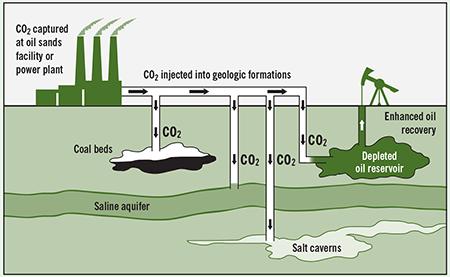Policies that Promote Clean Energy from Fossil Fuels
OnLocation presents the third and final blog in a series that identifies the top environmental and energy policy challenges for 2021 and beyond. This blog focuses on policies aimed at expanding the use of clean fossil-fueled technologies in the power and industrial sectors with the goal of reducing pollution while preserving fuel diversity, improving grid reliability, and utilizing low-cost domestic sources of coal and natural gas.
Arguably the biggest overarching challenge today is to mitigate the greenhouse gases that contribute to climate change. All energy-using sectors, including the power and industrial sectors, use a mix of energy sources that include fossil fuels (coal, oil and/or natural gas) that release energy-related carbon dioxide (CO2) emissions in the atmosphere. But what if these fossil-fueled technologies could capture and store CO2 instead of emitting it? These technologies exist today but in most cases are too expensive to implement without policy incentives.
This series of blogs provides policymakers, especially state energy offices and non-governmental organizations, with a clear vision of the benefits of each approach to reducing CO2 emissions, how different policy options can enable them, and considerations to make when choosing a path forward. Finally, we recommend integrated energy modeling for analyzing the various policy options.
Benefits of CO2 Capture, Utilization and Storage
CO2 capture, utilization and storage (CCUS) technologies have existed for many years but adoption in the U.S. has been very slow due to high technology costs, regulatory uncertainty, investment risk and other factors. There is no need to look any further than the failed FutureGen power plant in Illinois and Kemper power plant in Mississippi for evidence of the challenges faced by this industry. But recent technology advances and new policies such as the expanded Federal 45Q Sequestration Tax Credits are breathing new life into the CCUS market.
The term CCUS encompasses many technologies and methods that capture CO2 emitted during a variety of activities and transport it for use in enhanced oil recovery (EOR), concrete manufacturing and other beneficial uses, or permanently stored in underground geological structures. While CCUS technologies are relatively expensive, they have the potential to reduce CO2 emissions from the atmosphere while providing a reliable source of CO2 for EOR activities and other industrial processes.
There is a real need for “clean” (low CO2 emitting) baseload electric technologies such as CCUS to provide grid reliability, especially in areas with large amounts of variable renewable generation such as solar and wind. As described in our recent blog, electricity storage technologies can be used to cover the “shoulder hours” when the sun is rising or setting, but most storage technologies can only provide 2 to 4 hours of electricity at a time. Baseload technologies that can run 24/7 are needed to cover hours when the sun isn’t shining and the wind isn’t blowing, especially during the night. The recent California rolling blackouts may provide a good example of the need for reliable baseload power. Many are speculating that California’s policies have resulted in an over-reliance on variable renewable generation and imported power while continuing to retire much-needed fossil-fuel and nuclear baseload plants, making blackouts more likely in the future.
Negative Emission Technologies such as Direct Air Capture (DAC) and Bioenergy with CCUS (BECCS) have gained a lot of attention in recent years as another set of tools in the fight against climate change. DAC is a process that separates CO2 from ambient air and captures it for permanent storage or for beneficial uses, resulting in net negative CO2 emissions. Biomass absorbs CO2 as it grows so burning it as fuel is often considered to produce net zero CO2 emissions, so capturing those emissions in a BECCS facility and permanently storing them can be carbon-negative. However, some environmental groups are concerned about which biomass sources are truly carbon-neutral and about land-use issues that may result from large-scale use of the BECCS technology.

The current state of the CCUS market
According to the International Energy Agency (IEA) the number of large-scale CCUS projects operating worldwide as of June 2020 stands at 21, capturing roughly 37 million metric tonnes CO2 per year. Two large-scale CCUS projects for power have been operated successfully: one is the Boundary Dam retrofit coal plant in Saskatchewan; and the other is the Petra Nova retrofit coal project in Texas. Newly announced projects in the US have been spurred by recent changes made to the Federal 45Q Tax Credits.
In 2009, Congress enacted a tax policy referred to as Section 45Q Sequestration Tax Credits, which provides tax credits for CO2 captured at qualified facilities where the CO2 is used beneficially or permanently sequestered in a geologic formation. The 2009 tax credits, however, were too small and restrictive to incentivize the new technology. The Bipartisan Budget Act passed in February 2018 took the 45Q tax credits a step further by expanding the value of the tax credits available to CCUS projects, removing some of the restrictions, and extending the eligibility period. However, the number of new CCUS projects has fallen short of expectations.
So what policy options are available for expanding the use of CO2 capture technology?
Policies that promote CCUS technology deployment
While developers have learned a lot about CCUS technology based on existing projects, the industry is still considered to be in the early stages of commercialization. Targeted policies are needed to reduce costs and move this industry toward a sustained path of development.
Federal Tax Credits. The 45Q tax credits as written have not spurred the amount of new development originally hoped for, primarily due to the limited period of eligibility. There is not enough time remaining to successfully develop larger projects within the current commence construction deadline of December 31, 2023. Congress should consider extending the deadline to move the industry forward.
Federal Government Research & Development. The US Department of Energy (DOE) has contributed significantly to the advancement of CCUS technologies through their applied research programs at the National Energy Technology Laboratory’s (NETL) Research and Innovation Center, and by funding industry cost-sharing programs and university research grants. The Advanced Research Projects Agency—Energy (ARPA-E) has a FLExible Carbon Capture and Storage (FLECCS) program which is focused on developing CCUS technologies that can respond to rapidly changing grid conditions. Continued R&D funding is critical.
State Policies. Several states have enacted policies that can incentivize CCUS technologies. Examples include:
- California’s Low Carbon Fuel Standard (LCFS) provides incentives for CCUS related to transportation fuels (e.g., ethanol) and Direct Air Capture (DAC) technologies.
- Illinois’ Clean Coal Portfolio Standard Law that requires new coal facilities to capture and store at least 90% of their CO2 emissions and utilities to purchase at least 5% of their electricity from Clean Coal Facilities.
- New York’s Emissions Performance Standard limits CO2 emissions from power plants including baseload plants and simple cycle combustion turbines.
- Clean Energy Standards (CES) and Alternative Energy Portfolio Standards (AEPS) can also include CCUS in their list of eligible technologies.
Regulatory changes. While CO2 capture technology is improving, the regulatory hurdles surrounding the transport and storage of CO2 are holding the technology back. As described in an OnLocation blog, new legal and regulatory frameworks are needed to ensure that the transport and storage of CO2 is done in a manner that is safe and cost-effective.
Considerations to make when choosing a path forward
- CCUS technology cost and performance. CCUS technologies will continue to improve with market experience. Expanding the market with the right incentives and continued technology R&D funding is crucial.
- Plant Location. Locating CCUS plants close to storage sites can cut transport costs and co-locating with other CCUS plants can allow cost-sharing of infrastructure.
- Fuel Availability. CCUS technologies exist for coal, natural gas, and bioenergy, and every state has a different mix of resources available.
- New vs. Retrofit. Retrofitting an existing facility can reduce emissions while extending the plant’s lifetime and making use of existing infrastructure.
- Power vs. Industrial Facilities. CCUS can reduce emissions in a variety of different industries, especially for industrial processes with high-temperature heating requirements that cannot easily be met without fossil fuels.
- Storage Method for Captured CO2. Several options exist for storing or using the captured CO2 from CCUS facilities. Where available, beneficial uses of CO2 can provide another source of revenue for the CCUS facility.
How to analyze various policy options – integrated energy modeling
To fully grasp the complexity of an energy system, we recommend an integrated modeling approach. By “integrated,” we mean an energy model that analyzes how multiple sectors interact and how actions in one sector might stimulate or dampen activity in another. It is critical, for example, to understand how a policy favorable to CCUS such as the 45Q tax credits might affect both the power sector and industrial sector, including changes in fuel and electricity prices, competing sources of CO2 for EOR, and the domestic oil supply from EOR. Integrated modeling is a critical tool for sorting out these policy impacts and understanding the dynamics between the different energy sectors.
Want to learn more?
Check out our blog “The 45Q Sequestration Tax Credits: Congress’s Latest Boost for CCS Technologies” for more discussion of the benefits and challenges of CCUS technologies.
Download our free whitepaper “Integrated Energy Modeling & Analysis” to learn more about how integrated modeling can be used to inform policymakers.
Download our latest white paper “Top Environmental and Energy Policy Challenges for 2021 and Beyond” for more in-depth discussion of the policy challenges facing our world today, including the CO2 capture, transport and storage policies discussed here.

